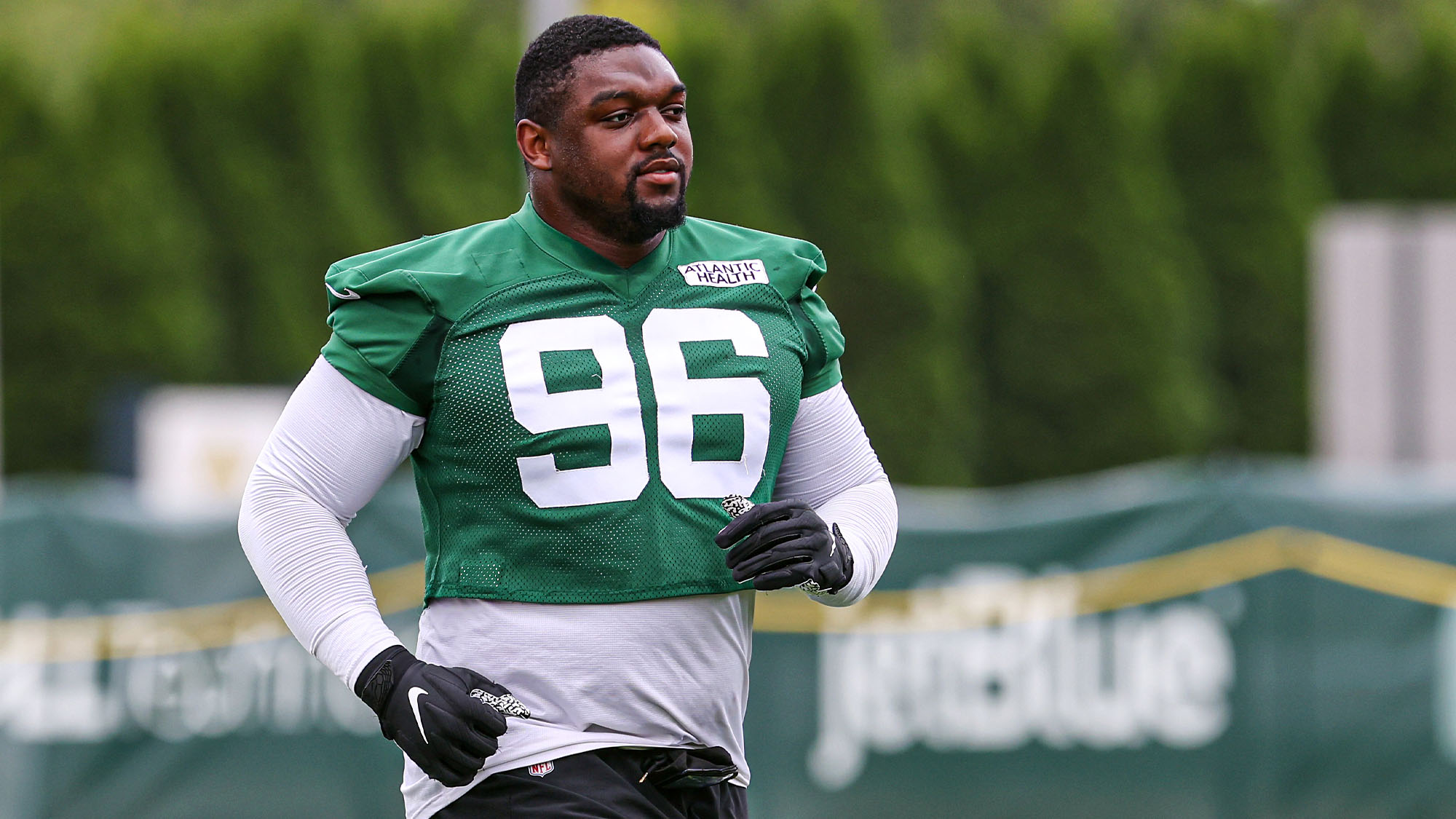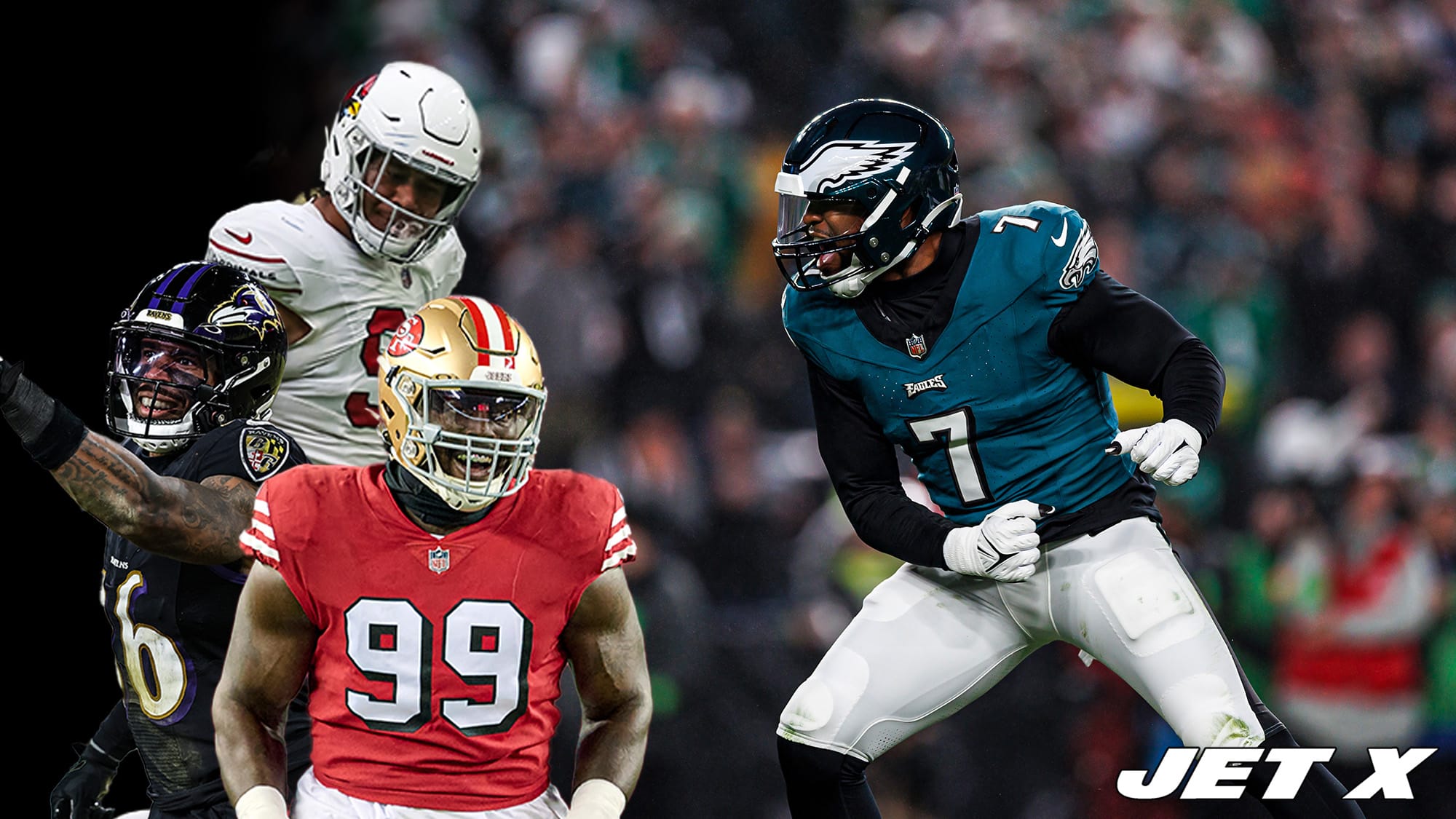Here’s how the New York Jets defense can survive against the run in 2022
The New York Jets‘ run defense has a shaky outlook entering the 2022 season. But there is hope for New York to tread water in this facet of the game if things break the right way.
Here are five things (in no particular order) that must happen for the Jets to concoct a good run defense in 2022.
1. D.J. Reed and Jordan Whitehead continue thriving
The Jets may not have done much to upgrade their run defense in the trenches, but they did make significant improvements to their back-end run defense.
Free agent pickups D.J. Reed and Jordan Whitehead are excellent run defenders for their positions. New York will need both players to continue stopping the run just as effectively as they have in the past.
Reed provides a reliable safety blanket from the outside cornerback position. He ranked fourth among cornerbacks with 29 total tackles against the run in 2021, and in the process, he only missed one tackle against the run.
This earned Reed a missed-tackle rate of 3.3% in the run game, which ranked seventh-best at his position. Reed’s tackling efficiency will be a huge boost for the Jets after their cornerback unit ranked fourth-worst in the NFL with 14 missed tackles in the run game last season.
Whitehead is a highly active playmaker around the line of scrimmage. In both the 2020 and 2021 seasons, he ranked fourth among safeties in run stops, collecting 19 of them in 2020 and 18 of them in 2021.
The Jets did not have an enforcer like Whitehead in their secondary. New York’s entire safety unit combined for only 18 run stops in 2021 (the same amount that Whitehead had by himself). That ranked fourth-worst among all NFL safety units.
It cannot be understated how big of a role the Jets’ secondary played in their run-stopping issues last season. New York allowed 16 rushes of 20+ yards, second-worst behind only Pittsburgh. That is an indicator of the secondary’s inability to prevent good runs from becoming great runs.
2. Jermaine Johnson hits the ground running
The majority of the Jets’ edge rushers tend to have skill-sets that lean toward pass-rushing (Bryce Huff, Jacob Martin, Micheal Clemons, the returning Carl Lawson). First-round pick Jermaine Johnson easily has the best two-way potential of any pure edge rusher on the roster.
Johnson is an NFL-ready player in the run game. He has great length to set the edge, is gifted with excellent speed to chase down plays, and showed good run-defending fundamentals in his college film.
At Florida State, Johnson combined high activity with high efficiency in the run game. Johnson was one of just 11 players out of 216 qualified FBS edge rushers to make at least 40 total tackles against the run while maintaining a missed tackle rate under 7.0%.
Considering they have so many other good pass-rushers in their defensive front, New York can afford to be patient with Johnson’s development as a pass-rusher. However, they need Johnson to succeed as a run defender right away. He is one of their few defensive linemen with legitimate high-level potential in the run game.
3. Quinnen Williams returns to 2020 dominance
Easily the best run defender on the team, Quinnen Williams needs to have a fantastic season to help the Jets overcome the lack of run-stopping talent around him.
Williams saw a slight drop-off in his performance from 2020 to 2021. That included a dip in the run game, one which saw him decline from dominant to very good.
While “very good” is nothing to sneeze at, it’s not enough for Williams to keep the Jets’ run defense afloat. He’s got to be unstoppable.
Unstoppable is exactly what Williams was as a run defender in the 2020 season. Williams amassed 28 run stops in only 13 games, leading all interior defensive linemen with 2.2 run stops per game. He picked up a run stop on 13.6% of his snaps against the run, placing second-best out of 97 qualifiers.
Williams’ numbers in 2021 were not quite as sparkling. Despite playing 15 games, his run stop total dipped to 25, giving him an average of 1.7 run stops per game. That slid him down to 15th among interior defensive linemen. His run-stop rate also dwindled to 10.0%, ranking 14th.
The Jets have a lot of players who can pick up the slack for Williams in the passing game if he has an off day. But if Williams doesn’t have his best stuff in the run game on a given afternoon, the Jets’ interior defensive line will probably be grounded-and-pounded all day long. His performance against the run will be incredibly important to the Jets’ success this year.
4. At least one non-Quinnen Williams defensive tackle steps up
Outside of Williams, it’s difficult to be confident about the run-stopping abilities of any other interior defensive linemen on the Jets’ roster. John Franklin-Myers, Sheldon Rankins, Nathan Shepherd, and Jonathan Marshall are all much better known for their pass-rushing than their run-stuffing.
Somebody has to step up and become a useful run defender. Even if it is just one guy, it would be huge for New York. Maybe it’s a longshot, but crazier things have happened in this sport.
Perhaps Marshall takes a leap in his second year. His elite athleticism gives a high ceiling in the Jets’ attacking scheme, although athleticism can actually be used against a defensive lineman if he can’t control it. Marshall needs to complement his athletic tools with good fundamentals and discipline to become a productive run defender.
Rankins was an adequate run defender earlier in his career before taking a nosedive in 2021. The Jets would probably be happy if he can just get back to league-average in this category.
Franklin-Myers is capable of using his size to provide great run defense on the edge, but he still needs to prove that he can hold up on the interior when his size is no longer an advantage. We did not see many run stops from him in 2020 when he was playing defensive tackle full-time.
This is a different scheme than the one Franklin-Myers played in back then, though, so perhaps this scheme will allow him to become a better two-way player on the inside. His explosiveness gives him the potential to be a destructive playmaker against the run as a defensive tackle in an aggressive 4-3 front.
Maybe the Jets’ answer to this problem isn’t on the roster yet. Could they rely on an outside addition to provide the beef they’re missing on the inside?
5. The non-C.J. Mosley linebackers improve
The Jets have a good idea of what they’re getting from C.J. Mosley in the run game. He wasn’t quite as consistent of a tackle-finisher in 2021 as he was in the past, but he’s still got a good nose for the ball and lays his share of hard hits. Overall, Mosley should continue to be a solid run defender. They have a reliable thumper to man the middle of their linebacker core.
But the spots beside Mosley are some of the biggest question marks on the Jets’ entire roster.
Quincy Williams, Hamsah Nasirildeen, and Jamien Sherwood are all undersized linebackers who got pushed around pretty easily in the run game last season. All three players also tended to struggle with reading plays and taking good angles.
The Jets have intentionally built their linebacker core with these types of players. They want speed and range at the position more than anything else.
But there are two costs to increasing your speed at linebacker: decreased size and increased risk of overrunning plays. Both issues plagued the Jets in 2021.
These guys can move, and when they hit their targets, their speed leads to some beautiful plays. When they miss, though, it’s ugly. And when you combine inexperience with speed, those misses become fairly common.
The goal is for the benefits of added speed to outweigh the accompanying negatives. That didn’t happen for the Jets last year. In 2022, the Jets will try to get their youngsters to sharpen their fundamentals to the point where they are making more highlights than lowlights.
New York’s young linebackers must take steps forward in 2022 for the team’s run defense to survive. If the Jets get more of the same, it will be difficult for their run defense to thrive even if things break right at other positions. The linebackers are the epicenter of the run game. Overcoming their struggles is difficult.
This position group’s progression will be a tremendous measuring stick for the developmental ability of the coaching staff. The Jets have declined to invest heavily in their linebackers for three consecutive seasons, instead electing to rely on a collection of low-investment players who are high on traits but lack fundamental and technical refinement. Can they teach these guys to harness their athleticism?
Robert Saleh and Jeff Ulbrich have a decorated history of coaching up young linebackers to become stars. Saleh tutored K.J. Wright and Fred Warner while Ulbrich worked with Deion Jones.
None of those three players were first-round picks. Can Saleh and Ulbrich work their magic again?













Great read, Michael. Thanks!
Interesting note about Jermaine Johnson from a historical perspective. Jets fans are always bemoaning the loss of John Abraham, the last really good outside pass rusher for the Jets, but they forget why he was let go. None other than Bill Parcells decided Abraham didn’t fit his defensive scheme because he would not play the run to his satisfaction, and Abraham made no bones that he wasn’t very interested in changing. So, Parcells said bye. He didn’t care for one-dimensional players. Now, in Johnson the Jets have drafted a pass rusher who also plays the run, and Parcells would probably give a thumbs up.
Herm Edwards had just completed his five-year stint with the NYJ (opening the door for Mangini) when Abraham was traded. Meanwhile, Parcells was about to start his final season as HC of DAL.
Good stuff! We need a lot to go right, hopefully we get a few of these things and get to top 24 in run defense and top 10 in pass defense. That would be ok for me, just can’t be bottom of the league.